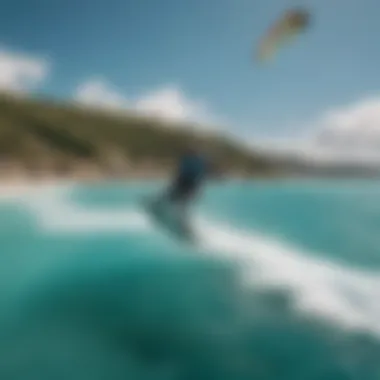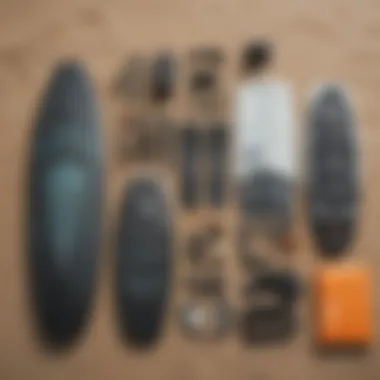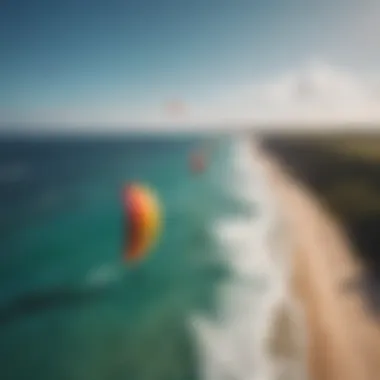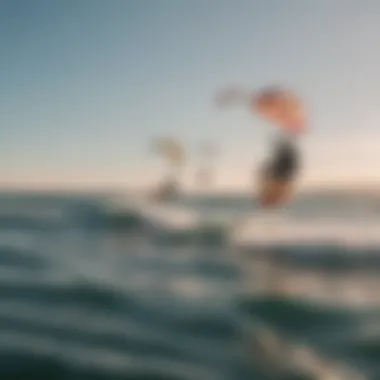Mastering ProKitesurf: Techniques, Gear, and Top Spots


Intro
Prokitesurfing isn't just another extreme sport; it’s a true marriage of skill and wind, drawing many enthusiasts into its exhilarating grasp. As kiteboards dance with the elements, the thrill is evident, yet it's essential to navigate this world with a blend of technique, gear knowledge, and an understanding of the right locations. Whether you're a seasoned rider or someone looking to dive in, you’ll find that mastering the essentials can elevate your experience and safety on the water. The following sections will dissect the nuts and bolts of gear selection, skill enhancement, and the dream destinations that all contribute to making prokitesurfing a beloved pursuit.
Gear Selection
Selecting the right gear is akin to a chef choosing the right ingredients for a dish; the right tools can significantly enhance not only your performance but also your enjoyment. When it comes to prokitesurfing, this means understanding the ins and outs of kites and boards.
Types of Kites
A kite serves as your primary propulsion device, and there are various types designed for different conditions.
- C-Kites: Known for their impressive performance in tricks and jumps, these kites are responsive and designed predominantly for advanced riders.
- Bow Kites: Excellent for beginners due to their stability, bow kites provide a big wind range and easier relaunch capabilities.
- Delta Kites: These kites blend the characteristics of both C-kites and bow kites, making them versatile for riders at different levels.
Choosing the right kite involves factors such as:
- Wind conditions
- Rider skill level
- Water type (flat, wave, etc.)
Understanding your environment and your capabilities is crucial when selecting the best kite. As wind can vary dramatically, having a few different kite sizes for diverse conditions is advisable.
Choosing the Right Board
Just as important as the kite, the board you ride affects your overall performance on the water. Boards typically come in several shapes and sizes, aimed at different styles of riding:
- Directional Boards: These are ideal for wave riding, allowing for better control and maneuverability.
- Twin-Tip Boards: Favorited for freestyle and freeride, these boards can be ridden in both directions, making them versatile and beginner-friendly.
- Foil Boards: An emerging trend, these boards lift above the water, providing a unique experience for smooth riding even in light winds.
When selecting a board, consider the following:
- Your riding style
- Weight and height
- Local conditions
"The right gear not only enhances performance but also adds to the fun and safety of the ride."
Choosing the appropriate gear is foundational in prokitesurfing, as it lays the groundwork for the skills you develop and the experiences you will cherish.
Skill Development
Mastering the craft of prokitesurfing thrives heavily on practice and improvement. Developing your skills involves not just learning basic maneuvers but refining techniques used by seasoned riders.
Essential Techniques
To gain confidence on the water, several essential techniques should be at the forefront of your training.
- Water Starts: Learning to get up on the board quickly can dramatically boost your ability to ride longer distances.
- Edge Control: Mastering how to control your board’s angle relative to the wind is vital for both speed and maneuverability.
- Transitions: Practicing smooth turns will not only keep you riding fluidly but also prepare you for more complex tricks.
Progression Tips
Each rider's journey is unique, but some tips can streamline your development:
- Find a local kiteboarding school. Learning from experienced instructors can accelerate your skill acquisition significantly.
- Regularly ride in various conditions. Adapting to different wind and water states strengthens your abilities.
- Jot down your progress. Reflecting on the techniques you’ve learned and noting areas for growth can keep you motivated and focused.
As you embark on your prokitesurfing journey, remember that every expert was once a beginner, and embracing challenges is an integral part of the adventure.
Intro to ProKitesurfing
ProKitesurfing represents a thrilling intersection of skill, adventure, and technology. This advanced form of kiteboarding effectively captures the essence of riding the wind and water in an exhilarating dance, where riders harness the power of the elements in a way that few other sports can. Understanding this discipline is more than just observing riders glide effortlessly over waves; it's about grasping the nuances and complexities that make this sport so captivating.
The importance of delving into ProKitesurfing lies in its multifaceted nature. For enthusiasts, instructors, and event organizers, having a thorough understanding allows for elevated skill acquisition and effective training methods. The connection between kite, board, and rider isn't merely mechanical; it embodies a profound relationship that can drastically affect performance. Recognizing these dynamics ensures that both new learners and seasoned veterans can enjoy the sport while minimizing risks.
Understanding ProKitesurfing
At its core, ProKitesurfing takes the basic principles of kiteboarding and elevates them to new heights. This sport requires a deep comprehension of not only physical techniques but also environmental factors. Riders must have a keen understanding of wind patterns, water conditions, and wave dynamics to navigate effectively. Each session on the water is a unique experience, often influenced by factors like tide shifts or sudden weather changes.
Even at the beginner level, grasping the fundamentals can significantly enhance a rider's experience. Simple skills, such as body posture and kite control, are the building blocks that help a rider progress swiftly.
Historical Evolution of Kiteboarding
The origins of kiteboarding can be traced back several decades, with various cultures experimenting with kites for various practical purposes. However, it wasn't until the late 20th century that it transformed into the extreme sport we recognize today. The development of kiteboarding equipment, from early parafoils to specialized performance kites, has dramatically changed the landscape.
Key developments in equipment, such as the introduction of inflatable kites and specific board types, have contributed to the rise of ProKitesurfing. These innovations paved the way for increasingly complex maneuvers and stunts, turning a hobby into a competitive endeavor on a global scale.
Notably, places like Tarifa, Spain, where strong winds meet scenic coastlines, have become vital hotspots for this sport, attracting professionals and curious beginners alike.
As ProKitesurfing continues to evolve, ingraining itself into local cultures around the world, the challenge lies in harmonizing the advancements in gear and techniques with the principles of safety and respect for the environment. By understanding the historical context, the contemporary rider can gain a greater appreciation for the sport's roots and its evolving nature.
Essential Techniques for ProKitesurfing
Essential techniques form the backbone of ProKitesurfing. Without a strong grasp of these skills, riding can become more of a struggle than a thrill. Mastery over techniques not only enhances performance but also boosts confidence on the water. Whether you're a newbie or a seasoned rider, the right set of skills can open doors to new tricks and maneuvers. Techniques can be tailored to different conditions, helping riders adapt their style as they encounter varying wind patterns and water conditions. In essence, understanding and applying these techniques is key to becoming a proficient pro-kitesurfer.
Mastering the Basics
Before diving into the more flamboyant maneuvers, it's crucial to get the fundamentals down pat. The basics include kite control, stance, and understanding how water and wind interact with your gear. These skills form the foundation for all advanced moves.
First, kite control entails knowing how to launch, steer, and land the kite properly. The stance should be balanced yet relaxed, allowing for quick adjustments. This part often requires rigorous practice - think of it as the bread and butter of kitesurfing.
Advanced Maneuvers


Once you’ve got your basics nailed, you can really start to push your limits with advanced maneuvers. This segment is where the fun multiplies exponentially. Here’s what you need to know:
Dynamic Turns
Dynamic turns are all about maintaining speed and flow while changing direction, which makes them a cornerstone for any kitesurfer aiming to refine their skills..
One key characteristic of dynamic turns is their versatility. By making tight cuts and shifting weight effectively, the athlete can continue to harness wind power while changing angles. This maneuver keeps momentum steady, a benefit when racing against the wind.
The unique quality here is in the ability to execute quick transitions. Riders don’t lose speed, which is essential in competitive settings. It requires excellent kite control but pays off by enhancing both efficiency and enjoyment.
Jumping Techniques
Jumping techniques elevate the whole experience, bringing in a thrilling element to kitesurfing. As you launch into the air, the kite's lift becomes crucial; your timing and understanding of your kite's relationship with the wind differ here greatly.
What characterizes jumping is the necessity for precision in execution. A well-timed jump can give you peak height, while poorly timed maneuvers might lead to less-than-desirable impacts. The uniqueness lies in the variations possible within jumping - from simple pops to complex rotations.
While jumping opens the door to creativity and personal expression, it also brings risks, especially regarding landings. Wrapping your head around this aspect is crucial as it can determine your safety and comfort while flying high.
Handling Strong Winds
Dealing with strong winds is another key component of advanced kitesurfing. Many riders shy away from these conditions, but learning to handle them can set you apart from others. Here, the kite’s responsiveness becomes key.
A key characteristic of handling strong winds is knowing when to depower your kite. This ensures that you catch the wind just right, keeping you in control while also preventing over-exertion.
The unique aspect of this skill involves strategic control - it’s all about leveraging the wind’s strength instead of fighting against it. However, it is not without its risks; mastering this can take time, but doing so gives you an upper hand in treacherous conditions.
Training Regimens for Enhancement
Training regimens play an indispensable role in elevating one's kitesurfing prowess. Consistent practice helps internalize the essential techniques while also building muscle memory. Setting aside time for drills, conditioning, and even stretching can lead to significant gains.
To enhance skills effectively, consider incorporating activities like strength training focused on the core and legs. A strong core aids in stability and balance during maneuvers. Moreover, cross-training with other water sports can stimulate muscle adaptation and enhance your overall agility on the kiteboard.
Keep in mind that improvement doesn't happen overnight. Commitment, patience, and a willingness to learn from both struggles and successes are vital parts of the journey. Engaging with the broader community can also offer different perspectives or drills that might introduce fresh ideas to your training regimen.
Selecting the Right Gear
Selecting the right gear for pro kitesurfing is more than just a matter of preference; it’s a pivotal aspect that can determine how enjoyable and safe your experience will be. Different equipment serves unique purposes and influences not only performance but also the rider's capability to adapt to varying wind and water conditions. The selection process emphasizes one key truth: the right gear fits like a glove, enhancing your experience rather than hindering it.
In this segment, we will explore the essence of kite selection, the differences between board types, and the safety gear that ensures you can kite with peace of mind. Each piece of equipment has been crafted with specific needs in mind, so understanding their functions will help you make informed choices.
Kite Selection
Types of Kites
When it comes to kites, not all are made equal. You’ll find various types catering to diverse riding styles and conditions. First off, let’s discuss the most common types:
- C-Kites: Known for their power, they work well for freestyle maneuvers. Their structure allows for good pop and are often the choice for competitive riders.
- Delta Kites: These kites are incredibly versatile, providing a large wind range and stability. Perfect for beginners and seasoned pros alike.
- Bow Kites: These have a larger surface area, giving them excellent lift and the ability to fly in lighter winds, making them a favorite for many.
Each type has its strengths. For instance, C-Kites can translate to more exhilarating jumps, whereas Delta Kites are often sought after for their all-around performance, making them beneficial for varied conditions. It’s essential to consider what you aim to achieve from your kitesurfing experience when making this choice.
Choosing Size and Shape
The size and shape of your kite can change the game. Smaller kites generally perform better in strong winds, while larger ones are ideal for lighter winds. The shape of the kite also plays a role in how it reacts to wind. For instance, a flatter kite offers less drag while providing quicker speed and better jumping abilities.
Each of these attributes affects your overall riding experience. For example, choosing a kite that is too large for the wind conditions can lead to a struggle, while a kite that’s too small may not generate enough power. Finding that sweet spot in size allows for an exhilarating experience that feels tailored to your riding style.
Board Types and Their Utilities
Selecting the board is just as crucial as selecting the kite. Boards are often categorized based on how they perform in the water, each suited for different styles of riding.
Directional Boards
Directional boards are designed to be ridden in one direction, much like a surfboard. Their primary strength lies in carving and riding waves, allowing for smooth transitions and controlled descents.
What sets them apart is their design which often includes a more pointed nose and a significant rocker, contributing to their efficiency in waves. However, one might find them challenging if they predominantly ride flat waters; this unique feature might not work to their advantage in flat conditions.
Twin Tip Boards
In contrast, twin tip boards allow for riding in both directions, offering tremendous versatility. They are often favored by beginners due to their forgiving nature and their adaptability across various water conditions.
Their symmetrical shape makes for easy maneuvering, yet this flexibility might limit performance in heavier wind situations compared to directional boards. Thus, while twin tips might be user-friendly, those seeking high-performance tricks often lean towards directional boards.
Safety Gear and Accessories
Safety gear cannot be overlooked when selecting your kitesurfing setup. Proper equipment not only protects you but can enhance your overall surfing experience.
Harnesses
Harnesses are crucial; they connect your body to the kite, redistributing the load and giving you the ability to control the kite effectively. A good harness should hug your body comfortably while allowing you to move freely. A poorly fitted harness can ruin your day on the water, leading to discomfort and loss of control. Different styles—waist vs. seat harnesses—offer distinct advantages based on personal preference and riding style.
Impact Vest
The impact vest is another safety gear that shouldn’t be neglected. Designed to offer buoyancy and protection during crashes, these vests can absorb the impact and fortify your chest and back. They often come in lightweight materials making them easy to wear without compromising mobility. Every seasoned rider can attest to the value of this piece of equipment, especially when venturing into trick-heavy sessions.
Helmets


Lastly, let's not forget helmets. Protecting your head is non-negotiable, particularly in a sport where you are often airborne. A quality helmet not only shields your head from potential impacts but also can keep your head warm in cooler conditions. They come in various styles with ventilation features that prevent overheating.
Always prioritize your safety gear; it can make a considerable difference in protecting you from unexpected mishaps.
The right gear is key to mastering ProKitesurfing. Each piece plays a role; understanding their features and how they contribute to your overall experience will keep you riding higher and longer.
Ideal ProKitesurfing Destinations
When it comes to prokitesurfing, choosing the right destination is crucial. The location sets the scene for an ideal experience, from wind conditions and wave intensity to overall scenic beauty. Featuring the right spots can make or break a session, considering elements like accessibility, weather patterns, and community support all play a role in a rider’s performance.
The enchantment of the ocean, combined with the thrill of mastering techniques on the water, creates a unique thrill only found in the best kitesurfing destinations. These locales not only provide the physical space to engage in the sport but also serve as cultural hubs for enthusiasts. After all, being surrounded by a community of like-minded riders can elevate the entire experience.
Top Global Locations for ProKitesurfing
The Maldives
The Maldives is often hailed as a kitesurfer's paradise. With its crystal-clear waters and consistent winds, it is an attractive choice for those looking to combine adventure with beauty. The key characteristic that stands out here is the uniqueness of the atolls, offering a range of spots to cater to different skill levels. However, the high costs associated with traveling here can be a disadvantage, making it less accessible for some.
One of the main reasons the Maldives is so popular among kitesurfers is its flat-water lagoons that are perfect for learning and performing tricks. The trade winds here typically blow from about November to April, providing ideal conditions. In addition to excellent kitesurfing, the surrounding marine life adds a stunning backdrop to your sessions, but do be aware of the need for eco-conscious practices due to fragile ecosystems.
Tarifa, Spain
Tarifa boasts a long-standing reputation as the kiteboarding capital of Europe. The region is notable for its consistent winds which flutter across the southern coast of Spain. Known primarily for its diverse wind conditions, Tarifa’s Levante and Poniente winds cater to both novice and advanced riders alike.
One of the unique features of Tarifa is the sheer variety of beaches, each offering something different. From wide sandy expanses to rocky coves, riders have plenty of options to explore. The vibrant local community is another plus; here, you can easily connect with instructors and fellow enthusiasts in vibrant beachside bars after a long day on the water. However, it can get crowded, particularly in peak season, which might not sit well with some looking for less hectic environments.
Cape Town, South Africa
Cape Town is often recognized as one of the finest destinations for kitesurfing, particularly due to its stunning landscapes and reliable wind conditions. What makes it special is the convergence of unique climate patterns around the Cape Peninsula, often resulting in optimal wind for several months of the year.
Kitekite Beach (or Blouberg), known for its large waves and strong winds, attracts many advanced riders, while more sheltered areas are perfect for those just starting. Cape Town's waterfront presents a myriad of cultural and social prospects, making it not just a place to kitesurf but also to experience a rich blend of local culture. Yet, like other hotspots, the variability of ocean conditions can pose a challenge for some kitesurfers.
Evaluating Local Conditions
Wind Patterns
Understanding wind patterns is essential for prokitesurfing. Different places exhibit unique wind characteristics that can significantly affect your ride. For instance, thermal winds, often caused by temperature differences between land and water, can be consistent in certain areas, providing an excellent environment for kitesurfing.
One of the key reasons why wind patterns matter is that they dictate the ideal times for riding. A good spot with reliable winds will ensure that you can practice consistently. That said, particular locations must be chosen wisely as offshore winds can create dangerous conditions for inexperienced riders.
Water Conditions
Water conditions can dramatically change your kitesurfing experience. One of the key aspects that stands out is the distinction between flat water and wave conditions. While flat-water settings are ideal for beginners and freestyle moves, waves can offer exhilarating challenges for experienced professionals.
The advantage of knowing specific water conditions includes being able to pick precise locations based on your skill level. Some areas may boast crystal-clear lagoons, while others may present turbulent waters that require significant skill to navigate successfully. Pay attention to previous riders' reports to gauge the conditions prior to heading out.
Seasonal Variations
Local conditions fluctuate based on seasons, and that's a crucial factor for any serious kitesurfer. Different regions see varying wind patterns and water conditions depending on the time of year, and understanding these seasonal shifts can greatly enhance your riding experience. For instance, some locations might see sustained wind patterns during summer months, while others become more favorable during winter.
Factors such as temperature, precipitation, and storm occurrence also contribute to seasonal considerations. Sometimes, optimal conditions for kitesurfing might disappear altogether in certain seasons; being aware helps you avoid disappointment and ensures that you optimize your time on the water.
"Picking the right spot is just as important as picking the right gear; understanding the unique characteristics can dictate your overall experience."
In summary, the ideal locations for prokitesurfing not only enhance the experience but also build community and skill level amongst riders. Whether you’re drawn to the tropical allure of the Maldives, the conducive winds of Tarifa, or the dramatic landscapes of Cape Town, knowing the waters and winds will always provide an enhanced ride.
Safety Protocols in ProKitesurfing
When it comes to prokitesurfing, safety isn't just a guideline, it's a cornerstone of the sport. Whether you're a seasoned rider or just dipping your toes in, understanding and implementing safety protocols can drastically mitigate risks and enhance the overall experience. The water may be inviting, but it's essential to approach it with a mindset grounded in caution and preparation.
Benefits of Safety Protocols:
By adhering to established safety measures, kiteboarders protect not just themselves but also fellow enthusiasts. Staying safe ensures that everyone can enjoy the thrill of the sport without sidelining accidents or injuries. This makes the kitesurfing community more cohesive and enthusiastic about sharing the waves. In the end, it can turn a casual ride into a shared adventure.
Understanding Risks
Diving into the ocean with a kite can indeed be thrilling, but it comes with its fair share of risks. From sudden weather changes to unpredictable water conditions, understanding the potential dangers is half the battle. Kiteboarders must be aware that factors like currents, tides, and even local wildlife can all play a role in their safety on the water.
Being cognizant of these risks means riders can make informed decisions about when to ride and how to manage the challenges that arise. A proactive approach in grasping these hazards can mean the diference between a good day on the water and a disastrous one.
Key Safety Measures
Ensuring a safe session starts long before you hit the water. Here’s where key safety measures come into play.
Pre-Session Preparations
Pre-session preparations are paramount for exhilarating and safe kitesurfing sessions. This involves more than just packing your gear; it’s about mentally and physically prepping for the ride ahead.
- Key Characteristics: Checking weather forecasts, understanding wave patterns, and ensuring your equipment is intact are crucial steps.
- Benefits: These considerations reduce the likelihood of accidents caused by gear failures or environmental factors. It's a beneficial choice to approach kitesurfing with a well-thought-out strategy.
- Unique Features: This might include completing gear checks or practicing your launching and landing techniques on dry land first. This reduces stress levels once in the water.
Identifying Hazardous Conditions
Knowing how to identify hazardous conditions can mean the diference between a fun session and a dangerous one. Not all wind is good wind; gusty, strong, or changing winds can shift quickly and catch even experienced kiteboarders off-guard.
- Key Characteristics: Observing local weather patterns, keeping an eye on changes in the sky, and talking to locals about seasonal conditions are just some methods to gauge safety.
- Benefits: Identifying these elements can help avoid situations where the water becomes too choppy or if thunderstorms loom on the horizon. This proactive approach can be crucial for safety while out on the water.
- Unique Features: Wearing a life jacket and using a safety leash tether can provide an extra layer of security, particularly in instances of boat traffic or wave surges.
Safety first means riding another day.


In summary, application of safety protocols in prokitesurfing is non-negotiable. Understanding risks, taking key safety measures, and preparing adequately can make a world of diference for any kitesurfer. The joy that comes from riding the waves should always be accompanied with a strong safety conscience.
Environmental Considerations in Kiteboarding
Understanding the environmental impact of kiteboarding is crucial for enthusiasts who wish to protect the natural playgrounds that host this dynamic sport. The beauty of kiteboarding lies not just in the thrill of riding the waves, but also in the natural spaces where it occurs, often characterized by pristine beaches and vibrant ecosystems. However, without proper care and consideration, these environments can suffer from the consequences of human activity.
This section will delve into the sustainable practices that riders can adopt, while also understanding the broader impact kiteboarding has on marine ecosystems. With the continuous growth of the sport, being aware of our ecological footprint is more essential than ever.
Sustainable Practices for Riders
Practicing sustainability is not merely a trend; it’s a necessity for maintaining the beauty and health of our recreational spaces. Kiteboarders can adopt various sustainable practices to minimize their ecological impact:
- Use Eco-Friendly Equipment: Choose brands that prioritize sustainability in their manufacturing processes. Opt for kites and boards made from recyclable materials.
- Leave No Trace: Always pack out what you pack in. This includes trash, gear, and personal items. Even the smallest bits of plastic can harm marine life.
- Respect Wildlife: Stay mindful of local wildlife, especially during nesting or breeding seasons. Maintaining distance from animal populations can help protect their habitats.
- Educate Others: Share knowledge about sustainable practices with fellow riders. Building a community that prioritizes environmental health can amplify impact.
By integrating these practices into their routines, kiteboarders can ensure that their sport is sustained for future enthusiasts to enjoy.
Impact of Kiteboarding on Marine Ecosystems
Kiteboarding does not exist in isolation; it directly interacts with the delicate balance of marine ecosystems. While riding, various activities can inadvertently disrupt wildlife and habitats. Here are a few considerations surrounding this significant impact:
- Erosion of Coastal Areas: Frequent activity in specific locations can lead to shoreline erosion. Riders should make an effort to rotate between spots to lessen pressure on any one area.
- Disruption of Marine Habitats: Kitesurfers often navigate through seagrass beds and coral reefs. These critical areas play a major role in supporting aquatic life, so being mindful of where to ride is essential.
- Pollution Concerns: Equipment maintenance often involves cleaning products and lubricants that can leak into the water. Opting for biodegradable alternatives can minimize this risk.
"Every kitesurfer holds a piece of responsibility when it comes to our oceans. Protecting what fuels our passions must be our shared priority."
By recognizing these potential impacts, riders can actively participate in preserving marine ecosystems. Through responsible choices and conscious practices, we can ensure that kiteboarding remains a vibrant part of coastal environments without compromising their integrity.
Emerging Trends in ProKitesurfing
The world of prokitesurfing is not static; it evolves constantly with innovations in technology and the growing popularity of the sport. By examining emerging trends, we can appreciate what shapes the future of kitesurfing and how these changes impact both newcomers and seasoned riders. This section highlights two key areas that are at the forefront of propelling prokitesurfing into new territories: technological innovations and the growth of competitive events. The developments in these areas not only enhance the experience for participants but also broaden the sport’s appeal to a wider audience.
Technological Innovations
Recent years have seen a boom in technological innovations within prokitesurfing. These advancements are not mere embarrassments of technical jargon; they transform how kitesurfers interact with their equipment and the environment. For example, new kites are being designed with lighter materials while still optimizing performance. This means that riders can achieve higher jumps and faster speeds without the equipment weighing them down.
Furthermore, innovations in control systems are making kites more responsive and intuitive for riders. Riders are no more guessing where they are headed based on how much pull they have in their harness. There are apps and gadgets that let you track wind patterns, kite performance, and even your own personal achievements. These tools offer metrics that can be especially valuable during training or competition. An example of this is the use of smart kites that come equipped with sensors for real-time data collection.
- Lightweight Materials: Enhancing performance without compromising durability.
- Smart Kites: Integrated sensors allow for better tracking and metrics.
- Control Improvements: More intuitive systems help with skill development.
These technologies don’t just create a better experience for the rider; they also reduce environmental harm by focusing on sustainable materials and designs. This focus on eco-friendly technology aligns with the growing awareness among kitesurfers regarding their impact on the oceans and ecosystems.
Growth of Competitive Events
Another significant trend in prokitesurfing is the growth of competitive events. As the sport gains popularity, events are popping up worldwide, giving riders a platform to demonstrate their skills. These competitions range from local contests to internationally renowned championships, attracting competitors from every corner of the globe.
- Professional competitions such as the World Kiteboarding League not only showcase top-tier talent but also raise the profile of the sport itself. With increased visibility, kitesurfing draws in sponsorships and media coverage, creating a virtuous loop that encourages the sport's expansion.
- Local events often foster community and give newcomers a chance to experience competition without the pressures felt at higher levels. This grassroots approach helps to cultivate engagement among enthusiasts, allowing them to connect with others who share their passion.
"As competitive events grow, they create a community spirit among kitesurfers, fostering relationships and camaraderie that extends beyond the beach."
The focus on competition has also led to the evolution of training methods. Riders are now more inclined to undergo rigorous training regimens, and new coaching methodologies have emerged, making use of the latest gizmos without losing the love for the sport.
In essence, the emerging trends in prokitesurfing push the boundaries of what’s possible. Riders have better tools, more opportunities for competition, and an increasing awareness of their environmental footprint. As these trends shape the future, both novice and experienced kitesurfers will find themselves navigating exciting new waters.
Community and Culture of ProKitesurfing
The culture surrounding prokitesurfing plays a crucial role in not just the sport itself, but in fostering a sense of belonging among enthusiasts. While the action of riding the waves with a kite can feel like a solitary endeavor, it is the community aspect that amplifies the experience. Riders often find themselves part of a global network that transcends geographic boundaries, united by a shared passion for the exhilarating thrill of kiteboarding. This community doesn’t just provide emotional support, but a wealth of knowledge that benefits both novices and experienced riders.
Connecting with Other Enthusiasts
One of the joys of being involved in prokitesurfing is the opportunity to connect with fellow enthusiasts. From local meet-ups at the beach to international competitions, there are countless avenues for riders to interact and share experiences. Events like the King of the Air in Cape Town or the Red Bull Kite Pass in Spain showcase top talent while fostering a communal atmosphere.
Participating in these gatherings, not only facilitates the exchange of tips on mastering new tricks but also helps in forming friendships that often last a lifetime. Furthermore, local kiteboarding schools and clubs provide beginner riders a space to connect with more seasoned ones.
Key benefits include:
- Skill Exchange: You can learn from others’ expertise, be it in jumping techniques or handling strong winds.
- Support Network: Sharing challenges with others can be incredibly motivating.
- Shared Experiences: Celebrating triumphs and navigating struggles together deepens bonds in the community.
The Role of Social Media in the Sport
Social media platforms have revolutionized how kiteboarders connect and share their passions. Sites like Facebook and Reddit serve as forums where riders can exchange ideas, discuss gear, and even arrange meet-ups. An online presence allows communities to thrive beyond geographical limitations, creating virtual havens for enthusiasts.
Instagram, in particular, has become a hotspot for showcasing skills and sharing breathtaking locations. Riders often post dramatic photos and videos that not only inspire others but also serve as informal tutorials, making it easier to grasp techniques.
Some significant aspects include:
- Real-Time Updates: Followers can keep tabs on events or local conditions by following organizers and other riders.
- Community Engagement: Engaging posts can lead to lively discussions, sparking innovation and camaraderie.
- Brand Promotions: Many brands leverage these platforms to showcase new gear and support local athletes, further integrating the community.
End and Future Directions
As we wrap up our exploration of ProKitesurfing, it becomes clear this sport weaves together thrill, community, and sustainable practices. There’s a beautiful intricacy to how it blends technical skills with an understanding of nature. Each ride harnesses not just wind and water but also respect for the environment that hosts our adventures. This section emphasizes how the sport is not just a fleeting trend but a growing commitment that evolves along with the advancements in technology and techniques. Balancing thrill and responsibility shapes the horizon for both newcomers and experienced riders alike.
Summarizing Key Insights
Over the course of this article, several pivotal insights stand out:
- Techniques and Skills: Mastering the art of ProKitesurfing isn’t just about the fancy spins or jumps; it’s about understanding the fundamentals and progressively working towards more engaging maneuvers.
- Gear Selection: The right equipment, from kites to safety accessories, can make a monumental difference in your performance and enjoyment. Choosing wisely, based on personal style and local conditions, is crucial.
- Destinations Matter: Each spot on the globe offers unique challenges and beauty. Understanding local wind patterns or seasonal behavior of waters can enhance the overall experience.
- Safety First: No ride can be enjoyed fully if safety is overlooked. Riders should adopt a proactive approach to assessing conditions and preparing adequately.
- Environmental Responsibility: Emphasizing sustainable habits ensures that the natural playground remains intact for future generations, helping the sport thrive in harmony with nature.
Looking Ahead in ProKitesurfing
The future of ProKitesurfing looks promising. As kiteboarding continues to grow, several trends are emerging that may define the next chapters of the sport:
- Technological Advancements: Innovations in kite designs enhance efficiency, making it easier and safer for various skill levels to participate. Lightweight materials and improved control systems are raising the bar.
- Expansion of Competitions: The rise of professional events and local competitions fosters a greater engagement, uniting riders and showcasing talent on both small and grand scales.
- Inclusivity and Accessibility: Programs aimed at introducing kiteboarding to broader demographics, including women and youth, are becoming more prevalent.
- Digital Communities: Online platforms, including forums on Reddit and Facebook, provide valuable spaces for sharing tips, experiences, and camaraderie among riders from all corners of the world.
In essence, ProKitesurfing is more than just a sport; it’s a lifestyle that encompasses adventure, respect for the environment, and a growing community that thrives on shared experiences and mutual support. As we look forward, the foundation has been laid for a flourishing future, inviting every kite enthusiast to ride the waves with passion and purpose.















